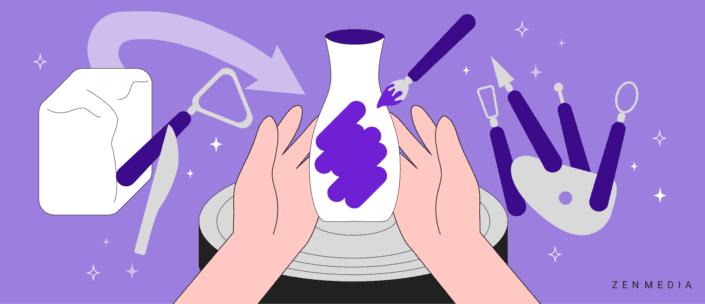Hands-on activities are my favorite. I love cooking, crafting, and seeing my work result in a final product. When I tried pottery for the first time in 2018, I was enamored with the spinning wheel and how my touch could manipulate the shape of clay, transforming raw earth from a soft lump to an actual bowl. Sadly, within a few months of learning to throw on the wheel, I broke my left arm—radius and ulna—due to a rollerblade fall. Ten pieces of metal surgically repaired my left arm. Pottery was out of the question for a while; physical therapy became my new activity by necessity. Eventually, I rehabilitated. I searched high and low for a studio that fit my needs until I found one at someone’s home nearby where I live in Miami. After a four-year hiatus, I returned to the wheel.
Pottery, to me, is a humbling experience. Unlike most things we do in a digital world of instant gratification, it requires steady pacing, patience, process-orientation, and physical raw materials. Potters know that no amount of effort or vigor will accelerate the time it takes to mold something from nothing. Rushing will only cause the piece to be uncentered or unstable, effectively on the verge of collapse.
As a writer, I notice metaphors everywhere. Pottery has helped me to better understand the process of molding content for B2B and B2C brands. Every piece of clay is different. So, too, every brand is different. The process, however, is the same, and the process is essential to a content strategy that wins market share.
Centering: Finding Alignment Through Iteration
The pottery process starts out with a piece of clay cut from a bigger chunk. The potter pats the slab into a packed sphere-like shape and slaps and seals it onto the wheel. The wheel needs to be damp (often wetted with a sponge) so that the clay adheres and doesn’t fly off. Next, the potter adds a generous amount of water so the clay stays constantly hydrated as it revolves in speedy circles on the wheel. This first step is called “centering,” and it requires the potter to lean against the wheel, cup the clay, pull it up, and push it down until it reaches the center point.
Centering is a lot like getting brand alignment and understanding who a brand really is. This is a back-and-forth process between the writer and the organization that is essential so that the writer can storytell in a meaningful way. When I get to know a new client, I need to center my understanding of their organization, where they are coming from and what their goals are. This centering includes listening to a customer and taking what they are saying at face value.
At the same time, it is essential to ask questions to get to the heart of what clients mean. “Here is what I heard; what do you think of this?” It’s the pushing and pulling in a conversation until the shared understanding is centered.
Opening and Lifting: Building from Outline to Draft
Once the clay is centered, it is time to open it up. By pressing on the top center point slowly downward, the clay begins to take form as a piece. Once the depth is established, the potter gently pulls the clay outward to open further.
I see the opening phase of pottery to be like forming an outline based on what I learned during the centering stage. Identifying the concepts that will contain the rest of the content helps to make messaging more robust and consistent. These are the core values, beliefs, and messages that the content strategy will reflect. As the shape is molded—as the content strategy is established—ensure that it accounts for content people will actually want to read. Even in pottery, sometimes I will make a vessel, and while it looks cool, it is so outlandish and impractical that I would never actually use it as a mug or a plate,
After opening up comes lifting the walls or continuing to manipulate the shape. This step is like writing the actual content, finding the words, sentence structures, and narrative that will be the end product. In pottery, this step requires a very careful touch that slowly but surely lifts bands of clay that are bonded together. The clay’s elasticity and stretch point have a breaking point, so care is crucial.
I see the lifting stage as using descriptive language, a clear narrative, and effective exposition to tell a story that conveys who a brand is and what they stand for as a high-quality brand. This stage is when the bulk of the writing takes place. The result should be high-quality content, like a well-made piece of pottery.
Trimming: Editing, Refining, and Polishing
After a piece of pottery is thrown, it needs a few days to a week to dry before it is trimmed. Trimming is one of my favorite steps because I enjoy holding the trimming tool and paying close attention to the outer shape of the piece. There is a rule in pottery that the outside should match the inside. That is another metaphor I really like because it speaks to all kinds of art and communication. There is always a core message that needs to come across, even on what seems like the surface level.
Trimming can be likened to the editing and refinement stage. Writers know that a lot of writing is editing and re-writing and that a writer needs to have a discerning eye. It is generally unusual that a draft or first pass becomes the final written content published.
Trimming requires a sharp tool, and it is essential to be careful not to cut the piece or lose control, which would result in the piece falling off the wheel. Editing content is about knowing what is needed to resonate with the ideal audience. As a writer, I often like a certain sentence or phrasing, and while it sounds sophisticated and interesting, it does not ultimately help a brand reach its business goals. So it has to go. The outside shape needs to match the inside shape; the content needs to match the brand.
Firing and Glazing: Publishing, Launching, and Taking a Stance
Ceramic pieces are fired twice. After trimming, the pottery is fired. Then, it is time for glazing. Glazing involves getting the fired, now-hard piece and dipping it in a paint bucket of a bisque glaze. I usually make my pieces an oatmeal color so that they are all neutral and uniform. (Talk about on-brand consistency.)
After the pieces are glazed, they are fired once again, and then they are finished. For the sake of comparing brands and content and pottery, firing and glazing is about stepping away from the work. Once you’ve established your brand guidelines, brand voice, and core offerings and go through the phases of throwing, trimming, and firing, it’s time to let the content stand on its own. You’ve done your part in shaping it and refining it to be the absolute best that it can be. Even an imperfect piece of pottery can end up being a beloved favorite. Every piece, every brand’s content, has its own place. As long as the process is followed and honored, the end result will be favorable.







